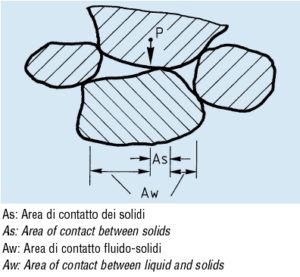
Siphoning
It is known that the excavations carried out below the level of outcrop of the aquifer cause continuous landslides of the bottom and walls. The evaluation of the forces that are transmitted to the ground can be done by considering an enlarged section of an immersed ground. The diagram shows the existence of forces that are transmitted between grain and grain in the contact area As (effective pressures) and of forces that are transmitted through the water that saturates the interstices of the ground in the contact area Aw (pressures neutral). It must be remembered that only intergranular pressures can produce volume changes in soil masses. The total pressure transmitted into the ground is linked to the effective pressure and to the neutral pressures, and it is given by the sum of the pressures. Digging below the groundwater level, the water assumes a flow through the voids of the ground, resulting in a filtration pressure proportional to the speed. In fact, there must be a certain hydraulic gradient to have a flow, which in turn is directly proportional to the flow velocity. By increasing the value of the hydraulic gradient and therefore the filtration pressure, a limit point is reached where the actual pressures are canceled, causing the so-called “siphoning” phenomenon.

Since there is no longer any contact between the granules, which tend to float, the ground is unable to bear any load and therefore continuous bubbling occurs at the bottom of the excavations. To solve this situation, the effective pressures must be increased through suitable filters, made of more permeable materials, in order to increase the effective pressures with their weight, while maintaining the neutral pressures unchanged.
The lowering of the groundwater that is obtained with the wellpoint system determines a decrease in neutral pressures and, therefore, an accentuated stabilization effect of the soil.

